What To See
Büyükada - Two Monasteries on Two Hills
- Details
- Created on 05 April 2013
- Last Updated on 12 July 2016
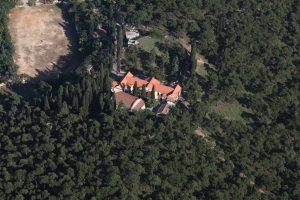 There are monasteries on both of the island’s hilltops, and there is a third on the eastern shore below Yüce Tepe, the southern peak. All three monasteries are accessible from the meydan at the waist of the island, to which one can take a fayton from the village.
There are monasteries on both of the island’s hilltops, and there is a third on the eastern shore below Yüce Tepe, the southern peak. All three monasteries are accessible from the meydan at the waist of the island, to which one can take a fayton from the village.
Isa Tepesi, the northern peak, is crowned with the monastery of the Transfiguration (Hagios Sotiros Christou). On the way up to the monastery one passes a huge wooden structure that once served as the Greek Orphanage, now abandoned and falling into ruins.
The monastery of St. George Koudonas crowns Yüce Tepe, the southernmost of the island’s two hills. A path leads up to the monastery from the meydan at the waist of the island.
The Monastery of the Transfiguration
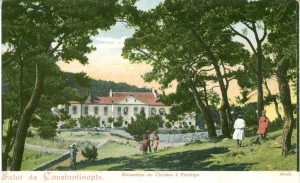 According to tradition, the monastery was founded in the Byzantine era, and implicit reference to it seems to have been made in a chrysobull issued in 1158 by the emperor Manuel I Comnenus.
According to tradition, the monastery was founded in the Byzantine era, and implicit reference to it seems to have been made in a chrysobull issued in 1158 by the emperor Manuel I Comnenus.
The monastery fell on hard times later in the Ottoman period, but it withstood these difficulties through the support of the guild of the Greek linseed oil merchants in Istanbul and an endowment from the Feneriote nobleman Pascharnikos Christodoulos Vlachoutsis. Patriarch Gregory V lived there in 1809; the former patriarch Chrysanthos moved to the monastery when he retired in 1826 and died there eight years later. Patriarch Sophronius was in residence during the years 1866-70, and through his efforts the monastery was restored and the present katholikon completed in 1869, in accordance with plans drawn by the architect Vasilis Dimitriou.
What remains of the monastery are its katholikon and an adjacent two-storey wing on its south, as well as some out-buildings on the western part of its grounds. The katholikon preserves the carved wooden iconostasis from the earlier church, gilded and decorated with floral and plant designs in both low and high relief. The doors of the Oraia Pylai are particularly notable, with eight small icons in their panels, the most remarkable being a depiction of the Annunciation, all dating from the eighteenth century. There is also a fine eighteenth-century Offertory Diptych, with Christ in the traditional Deesis representation atop the panels, flanked by the Virgin and St. John the Baptist. Set into the south exterior wall there is a replica of an ancient Greek funerary relief, dating from the second half of the nineteenth century.
The Greek Orphanage
 It is Europe’s largest wooden building, and the second largest in the world, according to Jak Deleon. The building was erected in 1898 by a French company, who planned to open it as a grand hotel called the Prinkipo Palas, with a gambling casino on the style of Monte Carlo. But Sultan Abdül Hamit II refused to give permission for such an establishment and it never opened. The building was then purchased by Eleni Zarifi, widow of the banker Leonidas Zarifi, who donated it to the Ecumenical Patriarchate on condition that it be used as an orphanage. The Greek Orphanage, which had been at Balıklı in Istanbul, reopened here in 1903, helped by a gift of 146 gold pieces donated by Abdül Hamit II, who also gave it tax-exempt status. The orphanage closed in 1964 and has since fallen into ruins, though it is still a most impressive site, one of the principal landmarks of Büyükada as seen from the sea.
It is Europe’s largest wooden building, and the second largest in the world, according to Jak Deleon. The building was erected in 1898 by a French company, who planned to open it as a grand hotel called the Prinkipo Palas, with a gambling casino on the style of Monte Carlo. But Sultan Abdül Hamit II refused to give permission for such an establishment and it never opened. The building was then purchased by Eleni Zarifi, widow of the banker Leonidas Zarifi, who donated it to the Ecumenical Patriarchate on condition that it be used as an orphanage. The Greek Orphanage, which had been at Balıklı in Istanbul, reopened here in 1903, helped by a gift of 146 gold pieces donated by Abdül Hamit II, who also gave it tax-exempt status. The orphanage closed in 1964 and has since fallen into ruins, though it is still a most impressive site, one of the principal landmarks of Büyükada as seen from the sea.
The Monastery of St. George Koudonas
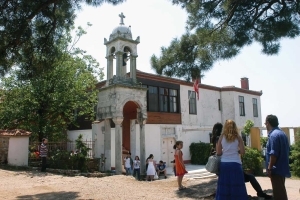 The monastery of St. George Koudonas crowns Yüce Tepe, the southernmost of the island’s two hills. A path leads up to the monastery from the meydan at the waist of the island.
The monastery of St. George Koudonas crowns Yüce Tepe, the southernmost of the island’s two hills. A path leads up to the monastery from the meydan at the waist of the island.
According to tradition, the monastery was founded in 963, during the reign of Nicephorus II Phocas (r. 963-9). The earliest reference to it is in the chrysobull of 1158 by Manuel I Comnenus mentioned earlier. The name Koudonas, which in Greek means "of the bells," comes from the story that a shepherd was grazing his flock on this hill when he heard the sound of bells coming from beneath the ground; when he dug down he found an icon of St. George, which he and other locals enshrined on the spot. This story is traditionally dated to the year 1625, and it probably represents the refounding of the monastery rather than a new foundation. Legend aside, the first abbot of record, Isaias, started building the present katholikon in 1752 and completed the main church of the Blachernitissa seven years later, also adding a number of monastic cells. Several additions were made in the following half century by the abbots Anthemios and Arsenios. Meanwhile a number of miracles were attributed to the icon of St. George, which was especially effective in curing mental ailments and in exorcizing those "driven by unclean spirits."
The present complex consists of six separate churches and chapels on three different levels, the older sanctuaries being on the lower levels. On the ground floor are the abbot’s house and the main church of St. George, both built early in the twentieth century. On the southern interior wall of the church is the original icon of Hagios Georgios Koudonas, now clad in silver. On a corner of the icon is a much later inscription, a moving appeal by a young Greek woman, who writes, "Dear St. George, help me go to Athens and study pharmacology."
A flight of steps leads to the first level below. Just beside the steps is a chapel of the Virgin Blachernitissa. Beyond that is another chapel of St. George, where iron rings set into the wall indicate that this was the place where mental patients were confined in the hope that they would be cured by the wonder-working icon of Hagios Georgios Koudonas. The room at the bottom of the stairs is a tiny shrine with an hagiasma, supposedly the place where the sacred icon of St. George was excavated. Beyond that is another chapel, dedicated to the Holy Apostles.
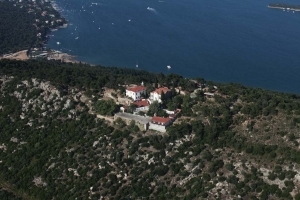 The feast day of St. George is celebrated on 23 April when thousands of pilgrims from around the world—including Muslim Turks and other non-Christians—make their way to the monastery, many of them walking barefoot up the hill to attend the dawn service. After the service many of the pilgrims have lunch at the little outdoor restaurant on the hilltop, celebrating the day that traditionally marks the beginning of spring according to the old calendar. The restaurant serves simple meals and snacks, as well as its own unlabled red wine. The hilltop is embowered in pines, cypresses, and other trees in a setting reminiscent of the Greek isles, particularly when the bells of the monastery are ringing in this ancient shrine.The feast day of St. George is celebrated on 23 April when thousands of pilgrims from around the world—including Muslim Turks and other non-Christians—make their way to the monastery, many of them walking barefoot up the hill to attend the dawn service. After the service many of the pilgrims have lunch at the little outdoor restaurant on the hilltop, celebrating the day that traditionally marks the beginning of spring according to the old calendar. The restaurant serves simple meals and snacks, as well as its own unlabled red wine. The hilltop is embowered in pines, cypresses, and other trees in a setting reminiscent of the Greek isles, particularly when the bells of the monastery are ringing in this ancient shrine.
The feast day of St. George is celebrated on 23 April when thousands of pilgrims from around the world—including Muslim Turks and other non-Christians—make their way to the monastery, many of them walking barefoot up the hill to attend the dawn service. After the service many of the pilgrims have lunch at the little outdoor restaurant on the hilltop, celebrating the day that traditionally marks the beginning of spring according to the old calendar. The restaurant serves simple meals and snacks, as well as its own unlabled red wine. The hilltop is embowered in pines, cypresses, and other trees in a setting reminiscent of the Greek isles, particularly when the bells of the monastery are ringing in this ancient shrine.The feast day of St. George is celebrated on 23 April when thousands of pilgrims from around the world—including Muslim Turks and other non-Christians—make their way to the monastery, many of them walking barefoot up the hill to attend the dawn service. After the service many of the pilgrims have lunch at the little outdoor restaurant on the hilltop, celebrating the day that traditionally marks the beginning of spring according to the old calendar. The restaurant serves simple meals and snacks, as well as its own unlabled red wine. The hilltop is embowered in pines, cypresses, and other trees in a setting reminiscent of the Greek isles, particularly when the bells of the monastery are ringing in this ancient shrine.
The view from the summit of Yüce Tepe is superb, encompassing all of the Princes’ Isles and the Asian shore of the Sea of Marmara, a prospect duly praised by Grosvenor, although the villages that he mentions have now all been amalgamated into the urban sprawl of Istanbul:
The view from this peak is the most extensive which Constantinople affords. From the height of six hundred and seventy feet the eye sweeps over the sea and comprehends the eastern shores of the Marmora. Northwest, beyond the island group, the fairy outline of Stamboul and Kadikeui fringes the sky, while the sombre point of Phanaraki advances in the foreground. North and east along the sinuous Asian coast, village presses upon village, each enriching the landscape with the tints of natural beauty or association.
Büyükada - Luna Park Meydanı
- Details
- Created on 05 April 2013
- Last Updated on 11 April 2013
The Monastery of St. Nicholas
 The monastery of St. Nicholas (Hagios Nikolaos) is on the eastern shore of the island, accessible by both the shore road and another road leading from the meydan below the summit of Yüce Tepe. The monastery is on or near the site of the Byzantine settlement of Karyes, which was abandoned in the seventeenth century after being devastated in a fire. The earliest mention of the monastery is by the English traveller Thomas Smith in 1680. The original katholikon of the monastery may have been built on and from the ruins of the parish church of Karyes. In 1783 the monastery temporarily housed a "School for Greek Classes," which subsequently was relocated near the Patriarchate in Istanbul as the Megale Scole, or Great School, which is still in existence.
The monastery of St. Nicholas (Hagios Nikolaos) is on the eastern shore of the island, accessible by both the shore road and another road leading from the meydan below the summit of Yüce Tepe. The monastery is on or near the site of the Byzantine settlement of Karyes, which was abandoned in the seventeenth century after being devastated in a fire. The earliest mention of the monastery is by the English traveller Thomas Smith in 1680. The original katholikon of the monastery may have been built on and from the ruins of the parish church of Karyes. In 1783 the monastery temporarily housed a "School for Greek Classes," which subsequently was relocated near the Patriarchate in Istanbul as the Megale Scole, or Great School, which is still in existence.
When the Greek War of Independence began in 1821 the monastery was taken over by the Turkish Army. Later it was restored and served to accommodate Greek families from Istanbul on visits to Prinkipo. A fire in 1852 destroyed the interior of the katholikon, including the iconostasis and most of the icons. The church was rebuilt in 1860 according to the original design, a domed four-columned cross-in-square, the plan of virtually all Constantinople churches of the medieval Byzantine era. The supposition is that the original katholikon preserved the plan of the parish church of Karyes, which is believed to have dated from the Byzantine period. The attractive narthex, covered with a tiled roof, dates to 1873. Over the entrance there is a marble relief of a double-headed eagle, emblem of the Palaeologus dynasty, who ruled Byzantium during its last two centuries. On the exterior at the northwest corner there is an ancient Greek relief representing a chariot race.
Büyükada - Important Villas and Mansion Houses You Can Encounter During Short Tour And Grand Tour Which You Can Do With A Coach Or Bicycle
- Details
- Created on 05 April 2013
- Last Updated on 11 April 2013
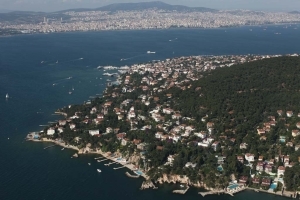 The street on the left side of the square leads to Fayton Meydanı, where all the horse-drawn carriages wait to be hired. The standard routes for visitors are the Büyük Tür (Grand Tour), a complete circuit of Büyükada, and the Küçük Tür (Short Tour), which does only the northern half, cutting across the waist of the island between Isa Tepesi and Yüce Tepe.
The street on the left side of the square leads to Fayton Meydanı, where all the horse-drawn carriages wait to be hired. The standard routes for visitors are the Büyük Tür (Grand Tour), a complete circuit of Büyükada, and the Küçük Tür (Short Tour), which does only the northern half, cutting across the waist of the island between Isa Tepesi and Yüce Tepe.
Büyükada - Center
- Details
- Created on 18 February 2013
- Last Updated on 11 April 2013
The Ferry İskele
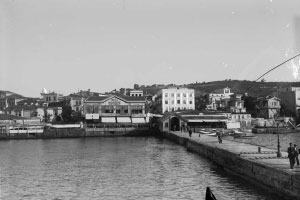 The lead-domed terminal building of the regular ferry, distinguished by its octagonal passenger hall, was designed in 1899 by the architect Mihran Azaryan of Izmit and completed in 1915. The tile revetment was made by Mehmet Emin Efendi of Kütahya. The upper floor was used as a cafe in the years 1918-23; from 1923-50 it was the District Office of the Republican Party’s Adalar (Islands) branch; in 1950-51 it housed the island’s first indoor cinema. The building was restored in 1999-2000, when Çelik Gülersoy of the Turkish Touring and Automobile Club created an elegant cafe on the upper floor, with a large balcony commanding a view of the Asian shore of the Marmara, an ideal spot to take refreshments before or after touring the island.
The lead-domed terminal building of the regular ferry, distinguished by its octagonal passenger hall, was designed in 1899 by the architect Mihran Azaryan of Izmit and completed in 1915. The tile revetment was made by Mehmet Emin Efendi of Kütahya. The upper floor was used as a cafe in the years 1918-23; from 1923-50 it was the District Office of the Republican Party’s Adalar (Islands) branch; in 1950-51 it housed the island’s first indoor cinema. The building was restored in 1999-2000, when Çelik Gülersoy of the Turkish Touring and Automobile Club created an elegant cafe on the upper floor, with a large balcony commanding a view of the Asian shore of the Marmara, an ideal spot to take refreshments before or after touring the island.


 What To See?
What To See?